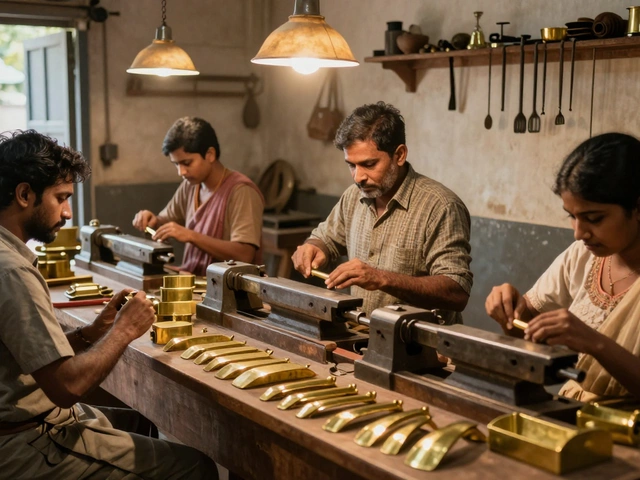Industries with Low Competition: Discover Untapped Business Opportunities in 2025

Pick up your phone and scroll LinkedIn for five minutes. There’s a good chance you’ll see more talk about digital marketing, dropshipping, and app development than you ever wanted. Feels like everyone’s an entrepreneur these days, and every idea you think of is already being done a thousand times over. If you’re worn out by the endless noise about “saturated markets,” you’re not alone. But what if I told you there are still wide, open spaces out there—actual, profitable industries with low competition, waiting for someone gutsy enough to step in? Forget chasing after the same old tech startup dreams. Instead, let's dig into where the real opportunities are hiding right now.
The Hidden Gems: Industries Flying Under the Radar
Most people think the only places for growth are in tech, but the most exciting business opportunities often show up where others aren’t even looking. Take specialty recycling for instance. Not just tossing bottles—think of companies that recycle old solar panels, wind turbine blades, or even electric vehicle batteries. Bain & Company reported in 2024 that only about 10% of end-of-life solar panels worldwide were properly recycled, with hundreds of thousands of tons set to pile up over the next decade. Someone needs to handle all that waste, and right now, the field is almost empty.
Another gem? Aquaculture tech—but not the kind you hear about when people mention overfished oceans. Ever tried seaweed chips? Kelp farming isn’t just eco-friendly; it’s in demand for food, animal feed, and bio-plastics. According to The Fish Site, global seaweed value hit over $17 billion in 2023, yet most farms are concentrated in just a few countries. In Australia, local producers are scrambling to catch up. Jumping in now means you’re in before the gold rush.
And then there’s urban vertical farming. People talk about food security, but fewer actually roll up their sleeves and build indoor leafy greens farms or compact mushroom-growing operations in city centers. Numbers from AgFunder show vertical farming funding actually went up 40% in 2024, but the everyday reality? Demand is outstripping supply in most cities because restaurant chains and supermarkets want locally grown, pesticide-free produce. Yes, it’s competitive in Silicon Valley, but in places like regional NSW or even Western Sydney, it’s wide open for fresh players. That’s not hype—that’s the actual gap between plates and supply chains.
Let’s look at a different sector: maintenance and repair of renewable energy equipment. As Australia keeps throwing up wind turbines and solar farms across the outback, there aren’t enough trained crews to keep the gear running smoothly. The International Energy Agency highlighted in late 2024 that the grid-scale renewables sector here could fall short of trained technicians by 28% over the next three years. Getting certified as an installer or starting a local repair outfit isn’t just about plugging holes—it’s about securing a business before most people realize there’s a shortage.
Finally, consider “silver tech”—products and services for the aging population, but not those tired personal alarm bracelets. Think customized online learning for retirees, AI-powered physiotherapy at home, and ergonomic home upgrades that allow people to age in place. The Australian Bureau of Statistics expects people over 65 to make up 22% of our population by 2032. Companies focusing just on solving daily annoyances for this demographic—like easier home gardening tools or simple tech troubleshooting—are still few and far between.
So, what makes these spaces different? The best part is there’s still room for first-mover advantage. When everyone else is focused on the latest SaaS or e-commerce trend, working in these less-talked-about fields almost guarantees you’ll face a fraction of the competition. You’re not fighting over slices of an already tiny pie—but baking something totally new.

Why Traditional Markets Are Clogged and How to Spot an Underserved Niche
It’s not just about picking something no one cares about. The trick is to find industries sitting in the awkward space between “not trendy enough” and “quietly essential.” Here’s the thing: The bigger the startup press hypes a market, the more people dive in, creating a feeding frenzy. Want proof? Just check how many microbreweries you spot around any Australian city. The result: more choice, but razor-thin margins.
The classic example: coffee shops. A café opens, and within six months, there’s another new “artisan” place across the street. Same story with digital agencies, small clothing brands, or even cloud kitchen concepts. The result? Everyone drops prices, and nobody makes serious money. That’s textbook oversaturation.
There’s a neat trick to finding better opportunities: watch for government incentives and grants in odd, non-sexy sectors. In 2025, the Australian government announced over $2.6 billion in support for cleantech upstarts and a slew of tax write-offs for local recycling startups, but barely anyone outside specialist circles noticed. Savvy entrepreneurs jumped in early, scored funding, and started growing before most folks even heard about it.
A concrete way to scan for opportunity is to look for broken supply chains or skills shortages. Take regional food processing—tons of local farmers produce amazing stuff but have zero access to packaging or cold storage. Starting a micro-packaging plant or even a logistics company that serves these breeders skips past the crowded playing field. Or, glance at the auto repair space for electric vehicles; right now, most mechanics have little training in EV tech, and workshops specializing in these systems are rare in outer suburbs.
One thing I’ve learned living in Sydney: listen to complaints. If you keep hearing business owners or everyday folks groan about the same problem—unreliable suppliers, delays, or lack of choices—it’s a good bet that’s an open door for someone new. And if your mates are all ignoring it because it’s “not exciting,” your odds just doubled. In the words of Steve Blank, famed Silicon Valley entrepreneur,
"No market is ever truly saturated if you’re solving a problem people still care about but everyone else ignores."
Watch out for false signals, though. Sometimes, what looks unsaturated is just unpopular for the right reasons (think: high upfront cost, tricky regulations, or customers who are slow to pay). That’s why it’s smart to chat with folks already working there, even informally, to sniff out whether you’re looking at a future trend or a dead end.
Also, don’t skip the B2B (business to business) world. While most people dream of flashy consumer brands, the real money often sits in supplying tools, tech, or services to other companies. For example, Australia’s explosion in plant-based meat companies led to a mini-boom in the need for bespoke food safety testing labs—super niche, barely crowded, and profitable for the folks who got in early. Same goes for custom software that manages rentals for small landlords, or cleaning services specializing in disinfecting co-working spaces. These niches rarely get overrun because they’re just not glamorous enough to attract a stampede.
If you want to get strategic, search public business registries for new company formations in your area and note industries where activity is growing but not spiking. Also, check trade show listings: if you spot upcoming expos for things like sustainable packaging or specialty logistics, chances are those sectors are bubbling just below the surface.
And a tip for the brave: consider exploring export markets. Everyone looks at U.S. or U.K. trends, but spots like the Middle East, Southeast Asia, or Africa often have far less local competition but rising demand for stuff we take for granted—eco-friendly building materials, drought-tolerant seeds, or compact medical devices.

How to Get Started in a Low Competition Industry
So you’ve spotted a promising, unsaturated sector. What next? First, you’ve got to go beyond Google research. Book a call with someone who actually runs a business in your target field. It’s rare, but seasoned owners will sometimes share what’s working and where the pain points are, especially if you’re based far away from their turf or not an obvious competitor. I once met the founder of a mushroom farm outside Wollongong who was more than happy to talk about supplier shortages and his constant hunt for new buyers—stuff no internet search would have revealed.
Second, test the waters before committing. Set up a pilot project or Minimal Viable Product—something simple, cheap, but functional. If you’re thinking of a recycling startup, for example, partner with one construction site or small council and see if your idea actually works in the real world. No point investing six figures before you know if anyone cares. People in niche industries usually appreciate creative solutions, especially if you’re filling a gap nobody else wants to touch.
Then, focus on building a strong network within the industry. Attend trade shows, online forums, and local association meetings, even if they sound a bit dry. You’ll bump into suppliers, learn which regulations matter, and maybe spot which service gaps everyone complains about. It might feel awkward at first, but these insider connections are like gold in industries that aren’t easy to Google.
- Unsaturated industries often don’t have the same online footprint as tech brands. Don’t expect slick websites or flashy LinkedIn posts—but that’s a good sign. It means you’re early.
- Dominate a small, niche market first instead of trying to scale too soon. Being the go-to expert in, say, remote solar farm servicing is better than being an also-ran in desktop software.
- Leverage local grants and economic development programs. Councils and state governments want new businesses to tackle their unique challenges, and you’ll face less scrutiny than in crowded fields.
- Pay special attention to compliance and environmental regulations. Countries like Australia have high standards, so get your paperwork right from day one—one slip-up in areas like food or waste can sink a new business faster than you’d believe.
- Track market signals: are competitors getting bought up, hiring more staff, or expanding to new cities? That’s your cue that demand is running hot and the window for easy entry is closing soon.
Finally, don’t assume bigger always means better. The best stories I’ve heard—from remote cold chain providers, to niche sustainable packaging makers—started out tiny and focused. They found an obvious gap, served just a few clients superbly well, and gradually expanded as the industry woke up. Once you’ve got two or three happy customers in a low competition space, word spreads fast because those industries are tightly knit.
To wrap it up: keep your eyes open for the complaints everyone ignores, the quiet industries with rising numbers, and the “boring” spaces outsiders joke about. If you can solve a real, persistent problem in one of these corners, you’ll never have to fight a crowded market again.





